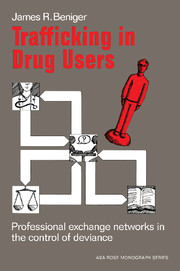Book contents
- Frontmatter
- Contents
- Acknowledgments
- Introduction
- 1 The emergence of the “drug problem”: social change versus social control
- 2 Control systems from exchange in networks: toward a synthesis of system and action theory
- 3 Stratification in information and referral exchange
- 4 Exchange relationships in social-control systems
- 5 The social system: boundary maintenance and hierarchical control
- 6 Summary: the control system in context
- Appendix A The data set
- Appendix B Subgroup sampling and estimated-density spaces (EDS)
- Notes
- Bibliography
- Name index
- Subject index
Appendix B - Subgroup sampling and estimated-density spaces (EDS)
Published online by Cambridge University Press: 07 May 2010
- Frontmatter
- Contents
- Acknowledgments
- Introduction
- 1 The emergence of the “drug problem”: social change versus social control
- 2 Control systems from exchange in networks: toward a synthesis of system and action theory
- 3 Stratification in information and referral exchange
- 4 Exchange relationships in social-control systems
- 5 The social system: boundary maintenance and hierarchical control
- 6 Summary: the control system in context
- Appendix A The data set
- Appendix B Subgroup sampling and estimated-density spaces (EDS)
- Notes
- Bibliography
- Name index
- Subject index
Summary
In many biological and social applications, the relationships that link individual units of analysis may have more substantive importance than any property of these units themselves. In such cases, standard statistical procedures apply only by assuming a population of relations (as, for example, when inferences about divorce are based on samples from a population of people interrelated by marriage and divorce). Such diversion of substantive concerns for the sake of statistical tractability has proved increasingly unsatisfactory in a growing number of applied fields: ecology and ethology, sociometry and small-group analysis, and the studies of kinship and formal organization, interpersonal influence and power structures, the diffusion of innovations and the spread of rumors, etc. Each of these areas has begun to develop its own quantitative methodologies based on applications of mathematical graph theory (Berge 1962; Flament 1963; Harary, Norman, and Cartwright 1965) and frequently grounded in iterative computer techniques. Unfortunately, these methodologies usually require complete enumeration or census procedures; there has been relatively little work on sampling and statistical inference for graphs (but see Goodman 1961; Bloemena 1964; Frank 1971, 1977, 1978; Wasserman 1977). For this reason, social-network analysis has been largely confined to small groups.
This appendix introduces a practical large-population method, identified as “subgroup partitioning,” for surveying networks of social relations. The formal treatment of statistical inference from subgraph samples of networks is summarized here, the practical limitations of subgraph surveys – as compared to the subgroup approach – are introduced, and certain inference procedures for subgroup surveys are formally developed (for details, see Beniger 1976).
Information
- Type
- Chapter
- Information
- Trafficking in Drug UsersProfessional Exchange Networks in the Control of Deviance, pp. 183 - 193Publisher: Cambridge University PressPrint publication year: 1984
